2 Player Perimeter Receiver Spot Drill
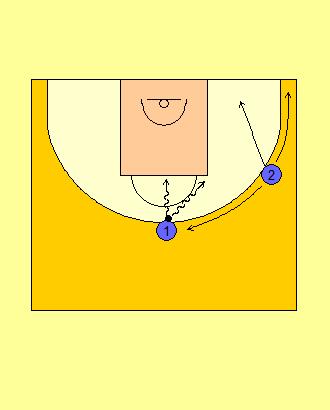
The 2 Player Perimeter Receiver Spot Drill focuses on player’s movements in the half court when there is dribble penetration inside the three-point line. The focus of the drill is in providing players with realistic and very specific overall tactical points about how to react to the movement of the ball. Players should be looking to react off the ball by moving into space and good receiver spots so they can make the most of any opportunities presented by player movement, offensively or defensively on the court. The 2 Player Perimeter Receiver Spot Drill moves players into where holes a likely to form within a standard offense, however, these can change depending on the formation being implemented by a team. The importance aspects of moving into space off the ball though are relevant to any offense. To make the drill more specific to a team’s needs simply vary the starting point of the ball around the perimeter for the best results that is individualised to a team’s offense.
The first phase of the 2 Player Perimeter Receiver Spot Drill looks at dribble penetration from the top of the keyway as depicted in Diagram 1 below. This can either be a dribble down the split line or to the strong side elbow.
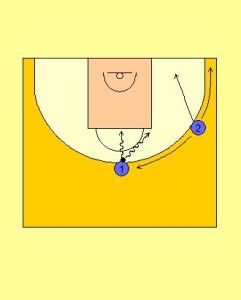
The player dribbling the ball (One) should look to always finish with a jump stop in a shooting stance to still allow for the option of shooting in game situations.
The player off the ball (Two) has three options:
- Lift and replace behind One (1) at the Point Position
- Flash towards the baseline for a mid-range jump-shot
- Fade into the corner for a three-point attempt
All three of these options, like all those presented within the 2 Player Perimeter Receiver Spot Drill should be drilled. The use of all variations will only serve to help players develop as a more rounded player, and provides opportunities for the technical development of aspects such as footwork in preparing for a quick release shot.
Phase 2 of the 2 Player Perimeter Receiver Spot Drill now looks to focus on the ball being dribbled baseline (Two) to the short corner from the wing. This is a common attacking scenario found in many offenses.
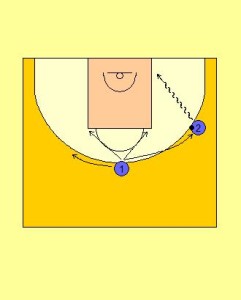
The player off the ball (One) will have four distinctive options:
- Fill in behind and replace the dribbler on the three-point line
- Move into the strong side elbow
- Move to the weak side elbow
- Move to the weak side elbow extended for the three-point shot
Variations will be common in regards to where the off the ball player (One) is desired to move. In some cases, it will be preferred for the player to move to the weak side elbow due to passing lanes and defensive rotations.
It is important to also be mindful of further variations to come when an additional offensive players (or two) is added to the scenario and where players will be drilled to move towards.
The third phase of the 2 Player Perimeter Receiver Sport Drill looks to now vary the attacking dribble lane to that of the elbow (Two). This simulates the common desired tactical movement of a dribbler coming over a screen.
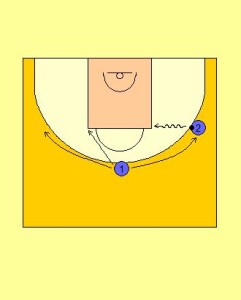
In this situation there are three options
- One (1) can fill and replace Two (2) on the wing for the possible three-point shooting opportunity
- One (1) can move into the weak side elbow
- One (1) can flare away from the dribbler looking to fill a weak side wing position for the three-point option
Catching a ball on the three-point line does not mean automatically that a player has to shoot a three-point attempt. What happens next after catching should be determined by the players own strengths and weaknesses around offensive production. For a player who has a strong three-point shot, the choice will be to catch and shoot. For another player the best offensive option might be to attack the basket. Coach to an individual’s strengths, not their weaknesses for the best success during games.
The fourth phase in the 2 Player Perimeter Receiver Spot Drill now looks at a player off the ball (One) now is being two passes away.
The scenario again starts with Two (2) driving towards the baseline finishing at the short corner.
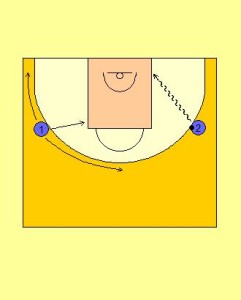
One (1) will have three options:
- Move to the weak side elbow
- Fill to the Point Position at the top of the keyway
- Sink into the weak side long corner
It is very important that when using the sink to the long corner that players do not move behind the line of the backboard. In this scenario, a player should be looking for the dribbler to help create the passing lane as moving into the long corner by the off ball player (One) this too much of a challenging shot.
The final phase in the 2 Player Perimeter Receiver Spot Drill is for Two to now dribble towards the strong side elbow.

There are four options to be explored for the off the ball offensive player (One):
- Flash towards the double block
- Flash towards the baseline for a mid-range jump shot
- Sink into the long corner for the three-point attempt
- Lift and fill the Point Position
All of the options presented here will help a player technically and tactically as they learn not only how what the options are off the ball, but also the way in which these movements are to be executed to lead to most favourable footwork and body position for a shot. The 2 Player Perimeter Receiver Spot Drill is a very solid drill and one that if was used more often would result in better outcomes for many teams from their perimeter players.








Leave a Reply